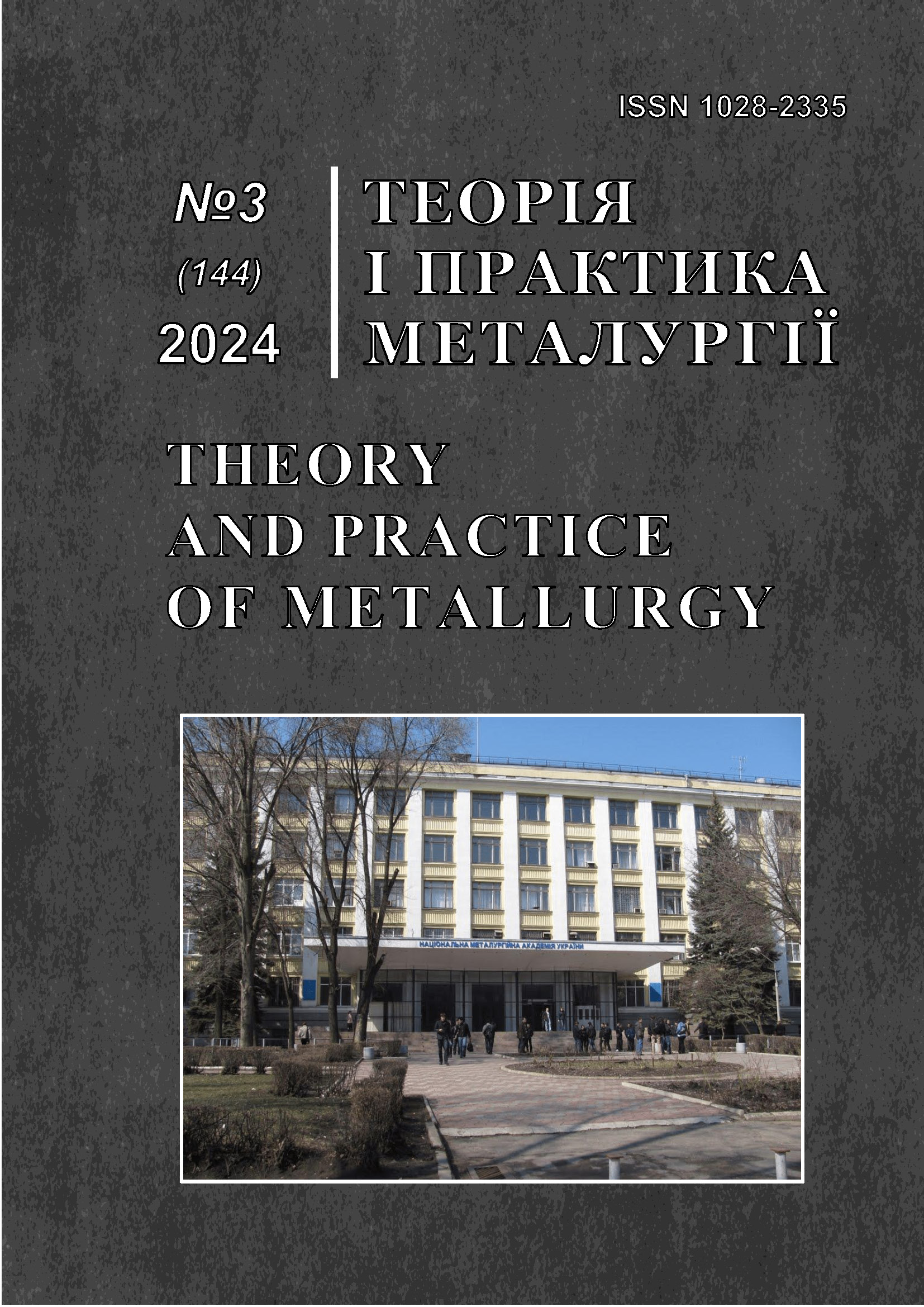Carbothermal reduction of iron oxides under electromagnetic influence
DOI:
https://doi.org/10.15802/tpm.3.2024.03Keywords:
carbon-thermal reduction, intensification, iron oxides, alternating electromagnetic field, reduction degreeAbstract
Objective. To obtain quantitative characteristics of the effect of the electromagnetic field on the process of reduction of iron oxides by carbon in the solid phase and to study the mechanism of this process, experimental studies of carbon-thermal and complex reduction of iron from hematite, magnetite, and rolling scale were carried out. Methods. The experiments were carried out in an alternating magnetic field of an induction furnace with an alternating current frequency in the inductor from 50 Hz to 40 kHz using the thermogravimetric technique. The reduction process was modelled under conditions of carbothermal reduction with the determination of the final degree of oxide reduction and the reduction time in the temperature range of 973-1373 K using various ore-coal materials. Results. The obtained data indicate an acceleration of carbon gasification and gas oxide reduction processes under the influence of EMF by 10-20 %. It was found that the influence of the magnetic field is higher the higher the frequency of the alternating current in the furnace inductor and that the influence of the magnetic field is higher in the low-temperature reduction ranges. Scientific novelty. The effect of EMF on the kinetics of iron oxides reduction has been experimentally confirmed. The mechanism of the field effect intensifying the iron reduction process is proposed. Practical significance. The intensification of the processes of carbon-thermal reduction of iron oxides provides a reduction in energy consumption and an increase in process productivity.
References
Simonov, V. K., & Grishin, A. M. (2012). Vliianie nizkochastotnogo elektromagnitnogo vozdeistviia na kinetiku vosstanovleniia zheleza gazami i razvitie diffuzionnykh protsessov. Elektrometallurgiia, 7, 12-26.
Walker, P. L., Rusinko, F., & Austin, L. G. (1959). Gas reactions of carbon. Advan. Catal., 11, 133-221
Molinari, E. (1968). Processes of photoadsorption on semiconductors and their relevance to the electronic theory of chemisorption. Electronic phenomena in chemisorption and catalisis on semiconductors. Moscow. https://doi.org/10.1515/9783111665832
Irradiation demage in graphite due to fast neutrons in fission and fussion systems. (2000). IAEA, Viena
Zhabarova, G. M., Vladimirova, V. I., Gesalov, A. A., & Kadenatsi, B. M. (1968). Electronic mechanisms of catolytic and chemsorption processes induced by ionizing radiation. Electronic phenomena in chemisorption and catalysis on semiconductors. Moscow. https://doi.org/10.1515/9783111665832
Jiang, G., Zheng, Y., Pan, J., & Tian, J. T(2012). he enhancement of pulverized-coal combustion by using sound waves. Journal of the Acoustical Society of America, 4(131), 3468-3468. https://doi.org/10.1121/1.4709076
Lall, V. (1991). Effect of acoustic oscillations on the burning of carbon. Daytona Beach: Embry-Riddle Aeronautical University
Kan, T., Mattat, L. M., Jagoda, J. L., & Zinn, B. T. (1998). Combustion of solids in an acoustic field. Atlanta: American Institute of Aeronautics and Astronautics, Inc
Yavuzkurt, S., Ha, M. Y., Reethof, G., Koopmann, G. H., & Scaroni, A. W. (1991). Effect of an acoustic field on the combustion of coal particles in a flat flame burner. Journal of Energy Resources Technology-transactions of The Asme, 4(113), 286-293. https://doi.org/10.1115/1.2905913
Radovic, L. R. (2012). Chemistry&Physics of Carbon, Boca Raton: CRC Press. https://doi.org/10.1201/b12960
Kim, K. Y., Jang, E. J., Kim, D. Y., & Jung, S. M. (2017). Effect of magnetic field on reduction of magnetite. Ironmaking&Steelmaking, 44(1), P. 6-16. https://doi.org/10.1080/03019233.2016.1152011
Alimer, D., & Rowe, M. W. (1983). Effects of a strong external magnetic field on reduction of cobalt and iron oxides: Confirmation. J. Chem. Phys.,78, 2094-2095. https://doi.org/10.1063/1.444920
Melander, M., Laasonen, K., & Jonsson, H. (2014). Effect of magnetic states on the reactivity of an FCC(111) iron surface. J. Phys. Chem. C, 118, 15863-15873. https://doi.org/10.1021/jp504709d
Chernavskii, P. A., Kazak, V. O., Pankina, G. V., & Perov, N. S. (2014). Effect of external magnetic field on the Co3O4 reduction kinetics. Kinetics and Catalysis, 55(1), 117-120. https://doi.org/10.1134/S0023158414010017
Karpacheva, G., Pankina, G., & Perov, N. (2023). Effect of an external magnetic field on the hydrogen reduction of magnetite nanoparticles in a polymer matrix. Magnetochemistry, 9, 123. https://doi.org/10.3390/magnetochemistry9050123
Jiang, J., Zhang, K., & Guo, J. (2024). Effect of magnetic field intencity on carbothermal reduction characteristics of Bayan Obo iron ore. JOM, 76, 3427-3438. https://doi.org/10.1007/s11837-024-06467-9
Jin, Y., Jiang, J., & Dai, H. (2023). Reaction characteristics of carbon-bearing pellets of Bayan Obo lean iron ores in a static magnetic field. J. Iron Steel Res. Int., 30, 1687-1700. https://doi.org/10.1007/s42243-023-00912-w
Svare, I. (1973). Effect of magnetic field on reduction of hematite. Nature physical Science, 244, 78-79. https://doi.org/10.1038/physci244078a0
Alymov, M. I., Seplyarskii, B. S., Rubtsov, N. M., & Vadchenko, S. G. (2020). Macrokinetic investigation of the interaction mechanism of the pyrophoric iron nanopowder compacts with air. Pure Appl. Chem., 92(8), 1321-1328. https://doi.org/10.1515/pac-2019-1112
Downloads
Published
How to Cite
Issue
Section
License
Copyright (c) 2024 Grishin O.M., Velychko O.G., Grek O.S., Nadtochiy A.A.

This work is licensed under a Creative Commons Attribution 4.0 International License.
Authors retain copyright of the published papers and grant to the publisher the non-exclusive right to publish the article, to be cited as its original publisher in case of reuse, and to distribute it in all forms and media. Articles will be distributed under the Creative Commons Attribution 4.0 International (CC BY 4.0) licence.
Authors can enter the separate, additional contractual arrangements for non-exclusive distribution of the published paper (e.g., post it to an institutional repository or publish it in a book), with an acknowledgement of its initial publication in this journal.




